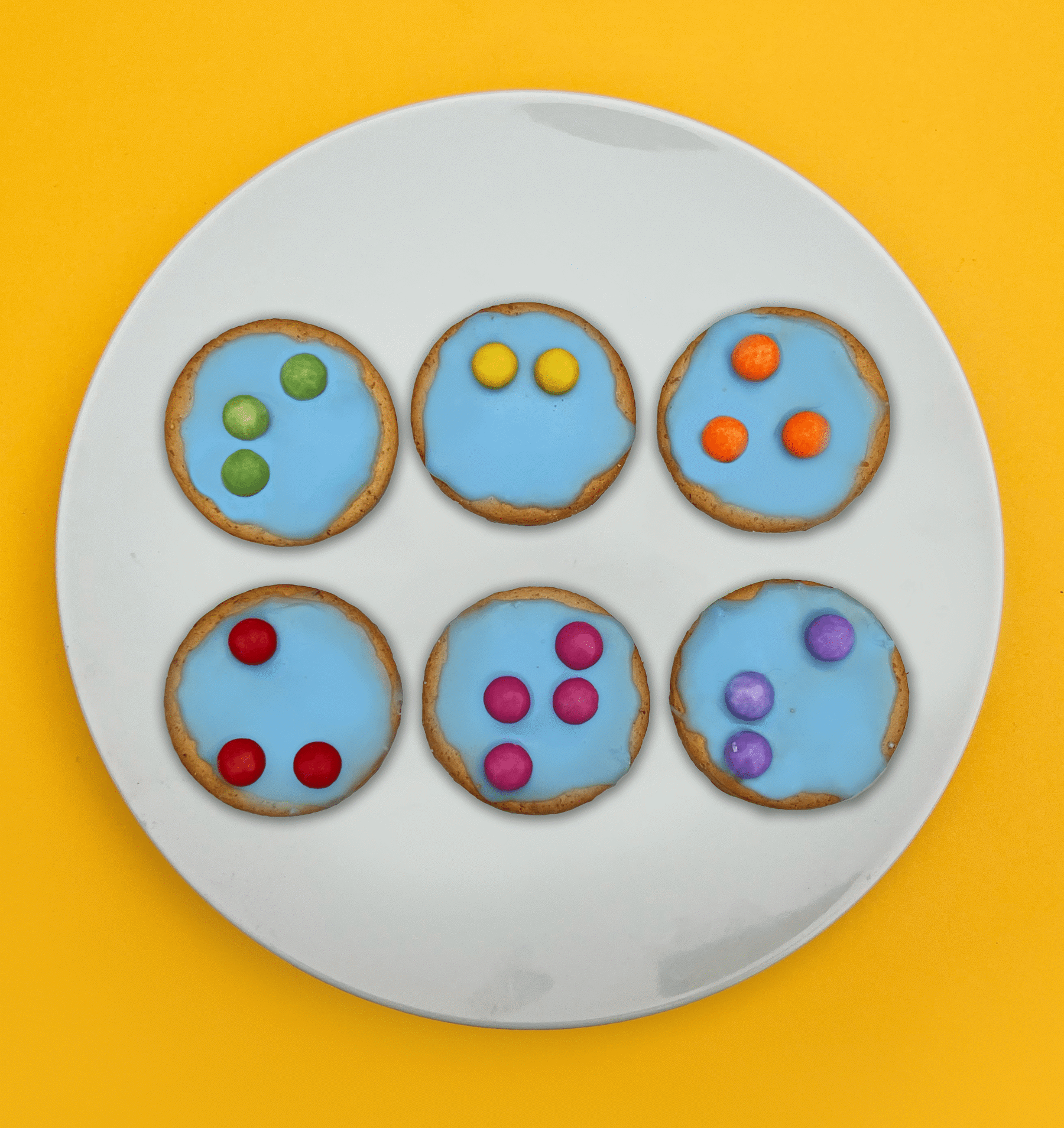
Make braille biscuits
You’ll need
- Food colouring
- Bowls
- Spoons
- Access to a sink
- Access to water
- Tables
- Paper plates
- Icing sugar
- Round sweets, such as smarties or M&Ms
Before you begin
- Use the safety checklist to help you plan and risk assess your activity. There's also more guidance to help you carry out your risk assessment, including examples. Don’t forget to make sure all young people and adults involved in the activity know how to take part safely.
Setting up this activity
- You may want to make the icing and separate out the sweets into bowls before starting this activity.
- Print out or write out copies of the braille alphabet for people to use.
- Check for any dietary requirements or allergies within your group before you begin and adjust the ingredients as needed, such as using gluten free biscuits and sweets. Make sure you have suitable areas for storing and preparing food.
- Remember to ask everyone to wash their hands regularly at the start and throughout this activity. Follow our food preparation guidelines to avoid the cross contamination of different, or raw and cooked, foods.
Run the activity
- Gather everyone in a circle and ask if anyone knows what a tactile feature is.
- Explain that tactile features use the sense of touch to provide information to someone. This tactile feature helps blind and partially sighted people identify different things.
- Ask if anyone can think of any tactile features that they may have seen or felt. Some examples are tactile pavements, when the pavement is textured or bumpier, as this can let people know where crossings and other road features are. Some banknotes, such as £10 and £20 notes, have different numbers of raised dots on them to help people tell them apart. The number ‘5’ on keyboards often has a raised dot on it let people know where their fingers are on the keypad/keyboard too.
- Ask if anyone has heard of Braille. Explain that Braille is a tactile code that enables blind and visually impaired people to read and write. It’s nearly 200 years old, and it’s based on a system of raised dots that are ‘read’ by people running their fingertips over them. There are 63 possible combinations of the six dots which are used to represent the alphabet and numbers.
- See if anyone has seen braille anywhere before. You might have noticed braille on the numbers in lifts or braille on medicine boxes from pharmacies.
- Explain that today you’re going to spell out the word ‘Scouts’, or another chosen word, in braille and on biscuits.
- Everyone should get into groups of six and assign each person a letter to make from the word ‘Scouts’ (or whichever word is chosen).
- The group should take a copy of the braille alphabet, then get ready at a table or in a space with a plate, icing, a spoon or knife, some biscuits and sweets.
- Ask everyone to put icing on the biscuits, then place it on the plate. Once it’s nearly set, add the circular sweets to the biscuit to spell out the letter, making sure to carefully copy the braille alphabet.
- When they’re set, put the biscuits in the right order to spell out the world, then eat the biscuits. If each group is making a different word, first go round and see if groups can guess each other’s words they’ve made.

Reflection
This activity was all about braille. What can you remember about tactile features and braille code? According to the Royal National Institute of Blind People (RNIB) there are around 20,000 braille users in the UK. These are mostly people who have had sight loss from birth or an early age.
What was it like making the biscuits? Did you find it easy to copy the braille alphabet and make the letters using the sweets? How did you work as team to make sure everyone could have a fair share of the sweets and icing? How did you choose which sweets to use, for example, did you use only one colour of sweet per letter?
Why do you think it’s even more important to have it on things like safety signs or medicines? Do you think there’s anywhere that should have braille that doesn’t? How could we improve that as a group, such as by writing to a company, asking for change in our local area or making our own Scout meeting place better?
How do you think technology is making it easier for people who are blind or partially sighted? Technology, such as audiobooks and screen-readers, means that blind and partially sighted people have access to things like websites or texts, without the need for braille, but braille’s still commonly found around the world. Why do you think it’s important for places to still have braille copies or use braille?
Safety
All activities must be safely managed. You must complete a thorough risk assessment and take appropriate steps to reduce risk. Use the safety checklist to help you plan and risk assess your activity. Always get approval for the activity, and have suitable supervision and an InTouch process.
- Food
Remember to check for allergies, eating problems, fasting or dietary requirements and adjust the recipe as needed. Make sure you’ve suitable areas for storing and preparing food and avoid cross contamination of different foods. Take a look at our guidance on food safety and hygiene.
- To make this activity harder, why not ask groups to write a message using the braille alphabet, then swap the message with another group for them to work out and read?
- Check for any dietary requirements or allergies within your group before you begin and adjust the ingredients as needed, such as using gluten free biscuits and sweets. Make sure you have suitable areas for storing and preparing food.
All Scout activities should be inclusive and accessible.